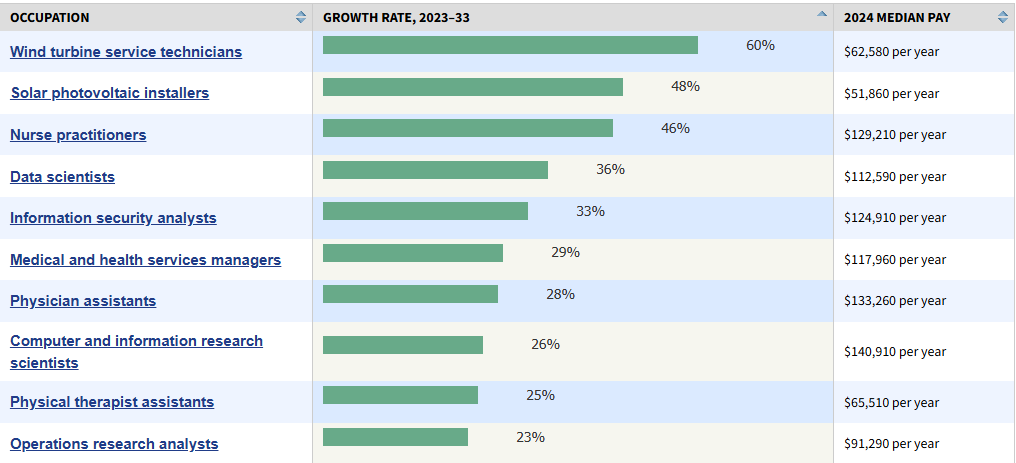As the workforce evolves in response to technological innovation, population trends, and the push for sustainability, certain career paths are emerging as clear front-runners for growth and opportunity. From wind energy technicians powering the clean energy movement to nurse practitioners expanding access to care, these roles reflect a changing landscape where practical skills, specialized training, and purpose-driven work converge.
10 Occupations With High Growth Rates Through the Next Decade
This article highlights 10 of the fastest-growing occupations in the U.S., according to the Bureau of Labor Statistics—each offering compelling prospects in terms of salary, stability, and demand across different regions. Whether you’re just starting out, considering a pivot, or getting out of the military, these careers are shaping the future of work.
1. Wind Turbine Service Technicians
- What they do: Wind Turbine Service Technicians – often called wind techs – are responsible for maintaining, troubleshooting, and repairing wind turbines that generate electricity.
- Education: Postsecondary nondegree award/on-the-job training.
Median Annual Salary: $62,580 - Projected Growth: 60%
- Number of Openings per Year: 2,100
- Regional Demand: Strong demand in wind-heavy Midwest states like Texas, Nebraska, Kansas and South Dakota.
2. Solar Photovoltaic Installers
- What they do: Solar Photovoltaic (PV) Installers are skilled professionals who assemble, install, and maintain solar panel systems that convert sunlight into electricity.
- Education: High school diploma plus on-the-job training or a post-secondary certificate; some vocational programs available.
- Median Annual Salary: $51,860
- Projected Growth: 48%
- Number of Openings per Year: 4,100
- Regional Demand: High demand in sun-rich states—California, Arizona, and Texas lead installations.
3. Nurse Practitioners (NPs)
- What they do: They are advanced practice registered nurses who provide comprehensive, patient-centered healthcare. They blend clinical expertise in diagnosing and treating health conditions with a strong emphasis on disease prevention and health management.
- Education: Master’s degree in one of the ARPN roles.
- Median Annual Salary: $135.050
- Projected Growth: 40%
- Number of Openings per Year: 31,900
- Regional Demand: Widespread need nationwide, especially in rural and underserved areas where NPs fill provider gaps.
4. Data Scientists
- What they do: This type of scientist analyzes large volumes of structured and unstructured data to uncover trends, patterns, and actionable insights that help organizations make better decisions. They sit at the intersection of statistics, computer science, and business strategy, making them vital players in today’s data-driven world.
- Education: Bachelor’s degree (often in math, stats, CS); many roles prefer a master’s degree.
- Median Annual Salary: $112,590
- Projected Growth: 36%
- Number of Openings per Year: 20,800
- Regional Demand: Centered in tech hubs—Silicon Valley, NYC, Boston, Seattle—but remote roles expanding.
5. Information Security Analysts
- What they do: These are cybersecurity professionals who protect an organization’s computer systems, networks, and data from cyber threats such as hacking, malware, and data breaches. They are on the front lines of defending digital assets in a world where cyberattacks are increasingly sophisticated and frequent.
- Education: Bachelor’s degree in cybersecurity, IT, or similar; professional certs (CISSP, Security+).
Median Annual Salary: $124,910 - Projected Growth: 33%
- Number of Openings per Year:17,300
- Regional Demand: Concentrated in cities with major private/financial/defense sectors – such as DC Metro area, NYC, Dallas.
6. Medical and Health Services Managers
- What they do: Also known as healthcare administrators or healthcare executives – they plan, coordinate, and direct the business side of healthcare. They ensure that medical facilities run smoothly, efficiently, and in compliance with laws and regulations, so healthcare providers can focus on delivering patient care.
- Education: Bachelors required; often supplemented by a Master’s (e.g., MHA, MPH); experience in healthcare settings.
Median Annual Salary: $117,960 - Projected Growth: 29%
- Number of Openings per Year: 61,400
- Regional Demand: Universal demand, especially in areas expanding healthcare systems (Sun Belt, large metro areas).
7. Physician Assistants (PAs)
- What they do: PAs are highly trained medical professionals who diagnose illnesses, develop treatment plans, prescribe medications, and often serve as primary care providers – all while working under the supervision of a licensed physician. They play a vital role in expanding access to high-quality healthcare, especially in rural and underserved communities.
- Education: Master’s degree from accredited PA program; state licensure.
Median Annual Salary: $133,260 - Projected Growth: 28%
- Number of Openings per Year: 12,900
- Regional Demand: Similar to NPs—rural regions and states that are expanding their PA scope see the fastest growth.
8. Computer and Information Research Scientists
- What they do: In a nutshell, these scientists are innovators who design new computing technologies and develop cutting-edge solutions to complex problems in fields such as science, business, healthcare, cybersecurity, and artificial intelligence. Their work lays the foundation for future advancements in software, hardware, and algorithms.
- Education: Typically requires a master’s or Ph.D. in computer science or a related field.
- Median Annual Salary: $140,910
- Projected Growth: 26%
- Number of Openings per Year: 3,400
- Regional Demand: Employment heavily clustered in research hubs, including Silicon Valley, Boston, Seattle, DC, and major universities.
9. Physical Therapist Assistants
- What they do: PTAs work under the supervision of licensed physical therapists to help patients recover from injuries, illnesses, or surgeries by improving movement, reducing pain, and restoring function. They play a hands-on role in carrying out treatment plans designed to increase patients’ physical strength, flexibility, and mobility.
- Education: Associate degree; state licensure required.
- Median Annual Salary: $60,050
- Projected Growth: 19%
- Number of Openings per Year: 27,500
- Regional Demand: High demand in aging-population regions that show strong demand due to rehab needs like Florida, parts of the Midwest and the South.
10. Operations Research Analysts
- What they do: Operations Research Analysts use advanced mathematical, statistical, and analytical methods to help organizations solve complex problems, make better decisions, and improve efficiency. They break down complicated business challenges into manageable parts and develop data-driven solutions that enhance performance and reduce costs.
- Education: Bachelor’s degree in operations research, math, engineering, or similar; master’s is common.
Median Annual Salary: $91,290 - Projected Growth: 23%
- Number of Openings per Year: 11,300
- Regional Demand: Hired by government agencies (especially D.C.), logistics firms, data-driven companies across major metros.
Occupations, Growth Rates, and Median Annual Salaries
NOTE: All data courtesy of U.S. Bureau of Labor Statistics
As technology evolves and industries adapt to meet global challenges, careers in sustainability, healthcare, data science, and cybersecurity are not only growing—they’re transforming the job market.
The ten occupations listed above represent some of the fastest-growing, highest-demand roles across the United States, offering strong salaries, diverse educational pathways, and geographic flexibility.
Whether you’re entering the workforce, changing careers, or planning for the future, these fields offer meaningful, stable, and forward-looking opportunities to build a successful and impactful career.





